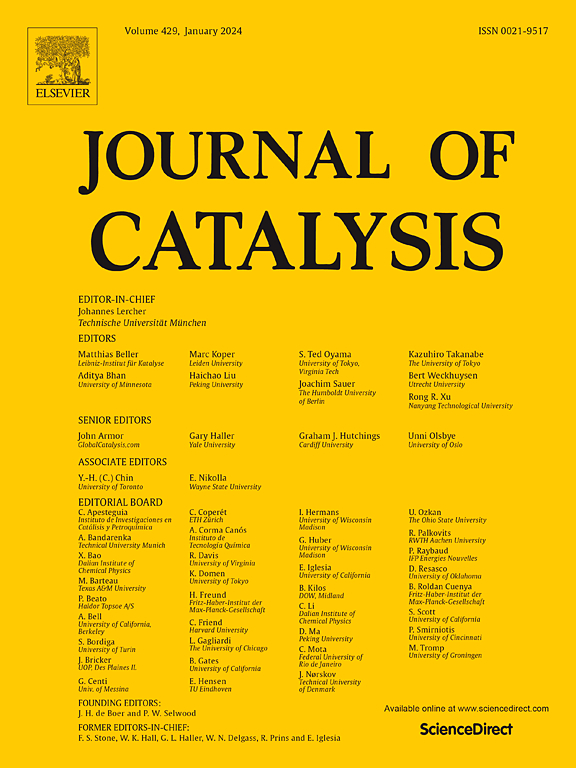机器学习加速了ni负载金属氮氨合成催化剂的界面流动性
IF 6.5
1区 化学
Q2 CHEMISTRY, PHYSICAL
引用次数: 0
摘要
在温和条件下开发高效氨合成催化剂对于减少工业Haber-Bosch工艺的能源需求和碳足迹至关重要。在本研究中,我们研究了利用b1结构的金属氮化物通过缔合Mars-van Krevelen (MvK)机制合成氨,重点研究了氮化锰(MnN),因为它具有低空位形成能和作为金属支撑界面的潜力。密度泛函理论(DFT)计算发现MnN (100)面是最稳定的,其表面有镍(Ni)纳米线促进H2解离,而表面氮空位激活N2。绘制了Ni-MnN (100)在400 °C时的自由能图,并建立了双位点微动力学模型来确定反应级数、表观活化能和限速步长(RDS)。为了捕获温度诱导的催化剂重组,采用从头算分子动力学(AIMD)模拟和机器学习原子间势(MLPs)来改进界面活性位点在较长时间尺度上的采样。我们发现显著的活性位点流动性导致活性位点结构重排,从而降低了空位形成能。反应温度下的氢覆盖分析揭示了Ni活性位点的动态重构依赖于覆盖,与Ni p-Band中心相关的RDS自由能变化降低。观察到mlp可以预测覆盖相关的流动性,训练数据只适用于高覆盖制度。通过整合DFT、AIMD和基于mlp的分子动力学,我们建立了一个理解过渡金属氮化物催化剂中动态金属-载体相互作用的计算框架,证明了它不仅适用于温和条件下的氨合成,而且适用于更广泛类别的负载催化剂和反应。本文章由计算机程序翻译,如有差异,请以英文原文为准。


Machine learning accelerated interfacial fluxionality in Ni-supported metal nitride ammonia synthesis catalysts
The development of energy-efficient catalysts for ammonia synthesis under mild conditions is crucial for reducing the energy demands and carbon footprint of the industrial Haber-Bosch process. In this study, we investigated ammonia synthesis via the associative Mars-van Krevelen (MvK) mechanism using B1-structured metal nitrides, focusing on manganese nitride (MnN) due to its low vacancy formation energy and potential as a metal-support interface. Density functional theory (DFT) calculations identified the MnN (100) facet as the most stable, with a nickel (Ni) nanowire implemented on the surface to facilitate H2 dissociation while surface nitrogen vacancies activate N2. A free energy diagram for Ni-MnN (100) at 350 °C was constructed and a dual-site microkinetic model was developed to determine reaction orders, apparent activation energies and the rate limiting step (RDS). To capture temperature-induced catalyst restructuring, ab initio molecular dynamics (AIMD) simulations and machine learning interatomic potentials (MLPs) were employed to improve the sampling of interfacial active sites over longer timescales. We found significant active site fluxionality leading to active site structural rearrangements that reduced vacancy formation energies. A hydrogen coverage analysis at reaction temperatures revealed coverage-dependent dynamic restructuring of Ni active sites, with lowered free energy change of the RDS that correlates with Ni p-Band center. MLPs were observed to predict coverage-dependent fluxionality with training data exclusive to high coverage regimes. By integrating DFT, AIMD, and MLP-based molecular dynamics, we established a computational framework for understanding dynamic metal-support interactions in transition metal nitride catalysts, demonstrating its applicability not only to ammonia synthesis under mild conditions but also to broader classes of supported catalysts and reactions.
求助全文
通过发布文献求助,成功后即可免费获取论文全文。
去求助
来源期刊

Journal of Catalysis
工程技术-工程:化工
CiteScore
12.30
自引率
5.50%
发文量
447
审稿时长
31 days
期刊介绍:
The Journal of Catalysis publishes scholarly articles on both heterogeneous and homogeneous catalysis, covering a wide range of chemical transformations. These include various types of catalysis, such as those mediated by photons, plasmons, and electrons. The focus of the studies is to understand the relationship between catalytic function and the underlying chemical properties of surfaces and metal complexes.
The articles in the journal offer innovative concepts and explore the synthesis and kinetics of inorganic solids and homogeneous complexes. Furthermore, they discuss spectroscopic techniques for characterizing catalysts, investigate the interaction of probes and reacting species with catalysts, and employ theoretical methods.
The research presented in the journal should have direct relevance to the field of catalytic processes, addressing either fundamental aspects or applications of catalysis.
 求助内容:
求助内容: 应助结果提醒方式:
应助结果提醒方式:


